The Concept of Privacy in Islamic Decor
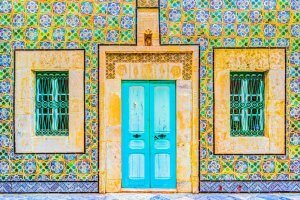
The reserved exteriors and deeply private nature of Islamic decor evoke a sense of exoticism and mystery. Below, we’ll show you some of the main features of Islamic architecture and design.
Interior decor is at the forefront of Islamic design. In other words, they attach great meaning to family life and comfort. As a result, the whole house is designed to preserve the privacy of its inhabitants and keep their secrets safely hidden.
While these buildings are highly functional, they’re also beautifully decorated. Great value is placed on aesthetics, which balance with the practical nature of the furnishings and layout.
Simple exteriors, bright interiors
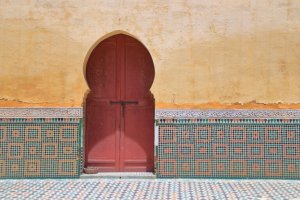
In most cases, the outsides of the houses have very little in the way of decor. They typically have only a few small windows, and thick walls made from low-cost materials. There are also very few openings to the outside world, and if there are, they are often furnished with trellises to give the occupants greater privacy.
At first glance, you might think that the inside of these buildings would be somewhat dark and somber. However, nothing could be further from the truth. Inside, you’ll find a burst of light, color, and decoration. What’s more, the interiors are all designed to make the very most of the space.
Islamic architecture boasts a very different look to most Western styles. Over the years, it has had a huge impact on the world of design, not just in terms of decoration, but also on an organizational, structural and functional level.
The true nature of Islamic design is found within.
Islamic decor – the inner courtyard
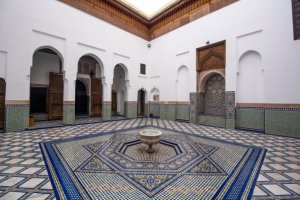
As we’ve already mentioned, these buildings have very few windows, meaning a second light source is required. Many buildings have a central courtyard or sehan, around which all the rooms are arranged.
- The light comes into the building indirectly via this inner courtyard, which helps improve airflow.
- The sehan is also cut-off from the street, giving it complete privacy from the outside world. On entering these buildings, you’ll usually find yourself in a hallway, which creates a barrier between public and private spaces.
Trellises
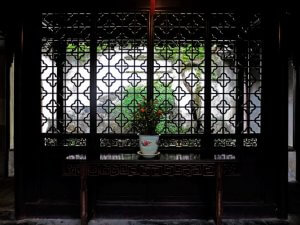
In this sense, Islamic designers seek to create a sense of privacy. Trellises are prominent features in many houses, allowing people to watch what’s going on outside, without being visible. They can be made of all kinds of materials, such as plaster, brick, metal, and wood.
Decoration and luxury in Islamic living rooms
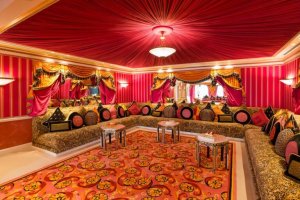
In contrast with the rather austere exteriors, the rooms inside are richly decorated. The hallways are also embellished with detailed patterns. However, humans and animals rarely appear in artwork, as some Islamic writings are said to forbid such drawings.
Islamic buildings are often decorated with inscriptions, as well as geometric and floral patterns.
Gold and silver form a key part of these designs. These precious metals are found in various decorative items throughout homes, such as lamps, tea trays, vases, and mirrors.
Islamic decor – a warm color palette

If you want your home to reflect the beauty of the desert, the typical color scheme used in Islamic decor could be a great source of inspiration:
- Try using warm tones such as red, maroon, ocher, and yellow. This color palette is typical of the Middle Eastern region.
- You can then create the perfect balance by mixing these warm tones with bursts of green and blue. These cool colors call to mind beautiful desert oases.
- This contrast will bring a sense of energy and life to your interiors.
The art of wood carving
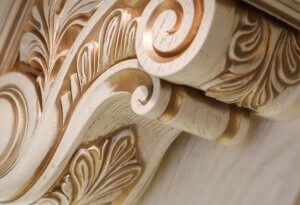
Islamic furniture is mainly made from wood, which is generally found throughout the entire house. Even the roofs are made of wood. Wooden objects are always exquisitely carved, with graceful arabesques, flowers, and ribbons.
- Ebony doors are a common feature. Richly decorated with geometric patterns, they’re true works of art.
- Another standard feature of Islamic design is the tea table. These can be made purely of wood or finished with a stone or glass tabletop. They’re typically fairly small and low to the ground.
- Last but not least, we can’t forget the roofs. While they do have a primarily structural function, they’re also decorated with carved wood and bright colors and adorned with large beams.
The reserved exteriors and deeply private nature of Islamic decor evoke a sense of exoticism and mystery. Below, we’ll show you some of the main features of Islamic architecture and design.
Interior decor is at the forefront of Islamic design. In other words, they attach great meaning to family life and comfort. As a result, the whole house is designed to preserve the privacy of its inhabitants and keep their secrets safely hidden.
While these buildings are highly functional, they’re also beautifully decorated. Great value is placed on aesthetics, which balance with the practical nature of the furnishings and layout.
Simple exteriors, bright interiors

In most cases, the outsides of the houses have very little in the way of decor. They typically have only a few small windows, and thick walls made from low-cost materials. There are also very few openings to the outside world, and if there are, they are often furnished with trellises to give the occupants greater privacy.
At first glance, you might think that the inside of these buildings would be somewhat dark and somber. However, nothing could be further from the truth. Inside, you’ll find a burst of light, color, and decoration. What’s more, the interiors are all designed to make the very most of the space.
Islamic architecture boasts a very different look to most Western styles. Over the years, it has had a huge impact on the world of design, not just in terms of decoration, but also on an organizational, structural and functional level.
The true nature of Islamic design is found within.
Islamic decor – the inner courtyard

As we’ve already mentioned, these buildings have very few windows, meaning a second light source is required. Many buildings have a central courtyard or sehan, around which all the rooms are arranged.
- The light comes into the building indirectly via this inner courtyard, which helps improve airflow.
- The sehan is also cut-off from the street, giving it complete privacy from the outside world. On entering these buildings, you’ll usually find yourself in a hallway, which creates a barrier between public and private spaces.
Trellises

In this sense, Islamic designers seek to create a sense of privacy. Trellises are prominent features in many houses, allowing people to watch what’s going on outside, without being visible. They can be made of all kinds of materials, such as plaster, brick, metal, and wood.
Decoration and luxury in Islamic living rooms

In contrast with the rather austere exteriors, the rooms inside are richly decorated. The hallways are also embellished with detailed patterns. However, humans and animals rarely appear in artwork, as some Islamic writings are said to forbid such drawings.
Islamic buildings are often decorated with inscriptions, as well as geometric and floral patterns.
Gold and silver form a key part of these designs. These precious metals are found in various decorative items throughout homes, such as lamps, tea trays, vases, and mirrors.
Islamic decor – a warm color palette

If you want your home to reflect the beauty of the desert, the typical color scheme used in Islamic decor could be a great source of inspiration:
- Try using warm tones such as red, maroon, ocher, and yellow. This color palette is typical of the Middle Eastern region.
- You can then create the perfect balance by mixing these warm tones with bursts of green and blue. These cool colors call to mind beautiful desert oases.
- This contrast will bring a sense of energy and life to your interiors.
The art of wood carving

Islamic furniture is mainly made from wood, which is generally found throughout the entire house. Even the roofs are made of wood. Wooden objects are always exquisitely carved, with graceful arabesques, flowers, and ribbons.
- Ebony doors are a common feature. Richly decorated with geometric patterns, they’re true works of art.
- Another standard feature of Islamic design is the tea table. These can be made purely of wood or finished with a stone or glass tabletop. They’re typically fairly small and low to the ground.
- Last but not least, we can’t forget the roofs. While they do have a primarily structural function, they’re also decorated with carved wood and bright colors and adorned with large beams.
All cited sources were thoroughly reviewed by our team to ensure their quality, reliability, currency, and validity. The bibliography of this article was considered reliable and of academic or scientific accuracy.
Pérez Ordóñez, Alejandro: Arquitectura doméstica tardoandalusí y morisca, Granada, 2008.







